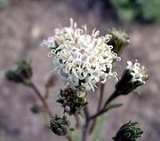
Chaenactis douglasii
Encyclopedia
Chaenactis douglasii is a species of flowering plant in the daisy family
known by the common name Douglas' dustymaiden. It is native to western North America from British Columbia
to Saskatchewan
to California
to New Mexico
, where it grows in a wide variety of habitats, including harsh environments such as rock fields in alpine climate
s in the Sierra Nevada, and disturbed areas such as roadsides.
The Chaenactis douglasii is a variable herb, generally a perennial. It grows erect to a maximum height near 50 or 60 centimeters, with one to many stems coated in cobwebby hairs. The woolly or hairy leaves may be up to 15 centimeters long and are divided intricately into many lobes with curled or twisted tips. The inflorescence
produces one or more flower heads
, each up to about 2 centimeters long. The flower head is lined with flat, glandular, blunt-pointed phyllaries
and contains several white or pinkish tubular flowers with protruding anthers
. The fruit is an achene
about a centimeter long including its pappus
of scales.
Asteraceae
The Asteraceae or Compositae , is an exceedingly large and widespread family of vascular plants. The group has more than 22,750 currently accepted species, spread across 1620 genera and 12 subfamilies...
known by the common name Douglas' dustymaiden. It is native to western North America from British Columbia
British Columbia
British Columbia is the westernmost of Canada's provinces and is known for its natural beauty, as reflected in its Latin motto, Splendor sine occasu . Its name was chosen by Queen Victoria in 1858...
to Saskatchewan
Saskatchewan
Saskatchewan is a prairie province in Canada, which has an area of . Saskatchewan is bordered on the west by Alberta, on the north by the Northwest Territories, on the east by Manitoba, and on the south by the U.S. states of Montana and North Dakota....
to California
California
California is a state located on the West Coast of the United States. It is by far the most populous U.S. state, and the third-largest by land area...
to New Mexico
New Mexico
New Mexico is a state located in the southwest and western regions of the United States. New Mexico is also usually considered one of the Mountain States. With a population density of 16 per square mile, New Mexico is the sixth-most sparsely inhabited U.S...
, where it grows in a wide variety of habitats, including harsh environments such as rock fields in alpine climate
Alpine climate
Alpine climate is the average weather for a region above the tree line. This climate is also referred to as mountain climate or highland climate....
s in the Sierra Nevada, and disturbed areas such as roadsides.
The Chaenactis douglasii is a variable herb, generally a perennial. It grows erect to a maximum height near 50 or 60 centimeters, with one to many stems coated in cobwebby hairs. The woolly or hairy leaves may be up to 15 centimeters long and are divided intricately into many lobes with curled or twisted tips. The inflorescence
Inflorescence
An inflorescence is a group or cluster of flowers arranged on a stem that is composed of a main branch or a complicated arrangement of branches. Strictly, it is the part of the shoot of seed plants where flowers are formed and which is accordingly modified...
produces one or more flower heads
Head (botany)
The capitulum is considered the most derived form of inflorescence. Flower heads found outside Asteraceae show lesser degrees of specialization....
, each up to about 2 centimeters long. The flower head is lined with flat, glandular, blunt-pointed phyllaries
Bract
In botany, a bract is a modified or specialized leaf, especially one associated with a reproductive structure such as a flower, inflorescence axis, or cone scale. Bracts are often different from foliage leaves. They may be smaller, larger, or of a different color, shape, or texture...
and contains several white or pinkish tubular flowers with protruding anthers
Stamen
The stamen is the pollen producing reproductive organ of a flower...
. The fruit is an achene
Achene
An achene is a type of simple dry fruit produced by many species of flowering plants. Achenes are monocarpellate and indehiscent...
about a centimeter long including its pappus
Pappus (flower structure)
The pappus is the modified calyx, the part of an individual disk, ray or ligule floret surrounding the base of the corolla, in flower heads of the plant family Asteraceae. The pappus may be composed of bristles , awns, scales, or may be absent. In some species, the pappus is too small to see...
of scales.

